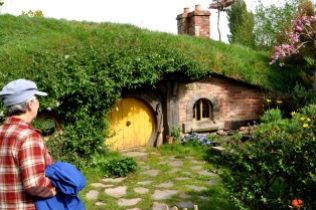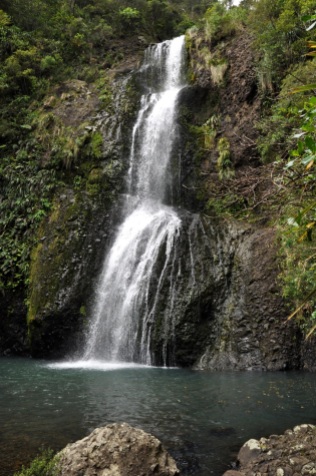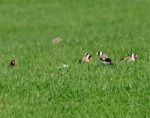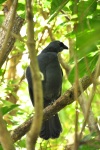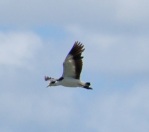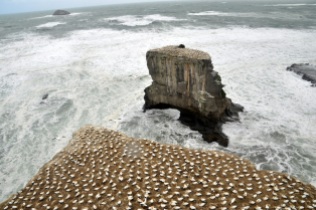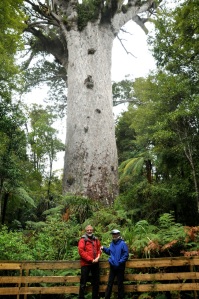That was the question. Not as momentous as “To be, or not …”, but still, it’s $75 a pop for a 1.5 hr tour of the Hobbit movie set, and c’mon, is this a made-up tourist thing or what? And we’re guarding our sheckles in this expensive country. So we said “No”, and then we thought – “We’re this close? Would our inner kids ever forgive us?” So here we are, not at all sure about our decision as a very rickety 1950’s repainted and frequently rehabbed school bus on its last legs lumbers and wheezes up, gears grinding, to take us to Hobbiton from the Shire’s Rest Cafe-and-souvenir-shop (just after a pouring rain ….). Hobbiton is the set left behind after filming the first Hobbit film. The Lord of the Rings filming built the place, but that Shire was made of plywood and styrofoam, meant to be removed. However, in the process of tearing it out the rains came and stopped the work, and then the locals starting showing up to see the location, and thus was born a tourist industry. For the first installment of the Hobbit, the Shire was rebuilt with an incredible (can I say maniacal?) attention to detail, and here it stands, expanded in fact for the 2nd Hobbit installment (but we’ll get to that).
The beautiful area was and is a very large sheep farm, chosen by Peter Jackson from
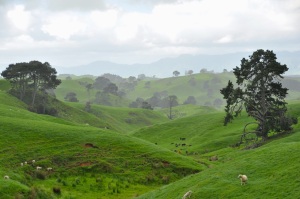
View of the area from Shire’s Rest.
an aerial search of this idyllic hilly land to correspond with Tolkien’s description. I’d like to show you an overview of the Shire, but the bus doesn’t stop, the road is bumpy, and the bus has no springs. Staying in the seat is hard enough, much less shooting a picture, and the view comes and goes. The best I can do is take a picture of the schematic on their brochure, so there it is in all its glory. Sigh. A real picture would have been cool. 
Anyway, back to the choice of the Hobbiton site; the existing lake already had a “party tree” in front of it, and importantly, there were no roads, buildings or electrical lines to mar the view. Peter Jackson got the NZ government to volunteer the NZ Army to spend 9 months building the road and site. At its peak, 400 people were on site for the filming of the few minutes of the Shire in the Lord of the Rings series.
On the bus our guide tells us we have to stay with him at all times and to keep on the trail that winds past many of the Hobbit houses. So there are real limits to picture taking – particularly  overviews! I will not be able to walk back up this road, for instance. Groan! And we paid how much money? And then we’re there, and the doubts melt away, because it’s fabulous. Peter Jackson’s attention to detail is stunning. Perhaps this is a requirement for movie directors? The budget for this movie was astronomical, yet Jackson managed to overspend by quite a few million (the movie, of course, was in the black after opening day, so there weren’t many complaints). As an example of Jackson’s approach, he needed an oak tree on top of Bilbo’s house (Bag End) at the top of the Shire, so he found the one he wanted elsewhere, had it cut down, the branches numbered and cut off, and transported and re-assembled at Bag End. He then imported artificial leaves from Taiwan and had them individually wired onto the dead tree. And there it is today, unchanged, as shown in the picture. Similarly, Jackson creates a small orchard of plum trees since Tolkien writes of a child under a tree eating plums with pits piled up; but the tree shapes are all wrong to Jackson, so he has them pulled out and “Hobbit-like” apple and pear trees planted. However, with the shooting sufficiently delayed in spring, the trees are leafing out and they are not plum leaves. Well, that won’t do, will it? So for filming he
overviews! I will not be able to walk back up this road, for instance. Groan! And we paid how much money? And then we’re there, and the doubts melt away, because it’s fabulous. Peter Jackson’s attention to detail is stunning. Perhaps this is a requirement for movie directors? The budget for this movie was astronomical, yet Jackson managed to overspend by quite a few million (the movie, of course, was in the black after opening day, so there weren’t many complaints). As an example of Jackson’s approach, he needed an oak tree on top of Bilbo’s house (Bag End) at the top of the Shire, so he found the one he wanted elsewhere, had it cut down, the branches numbered and cut off, and transported and re-assembled at Bag End. He then imported artificial leaves from Taiwan and had them individually wired onto the dead tree. And there it is today, unchanged, as shown in the picture. Similarly, Jackson creates a small orchard of plum trees since Tolkien writes of a child under a tree eating plums with pits piled up; but the tree shapes are all wrong to Jackson, so he has them pulled out and “Hobbit-like” apple and pear trees planted. However, with the shooting sufficiently delayed in spring, the trees are leafing out and they are not plum leaves. Well, that won’t do, will it? So for filming he  repeats his tree trick, plucking the leaves off an apple tree and wiring plum leaves from Japan in their place. I can roll my eyes at this perfectionist thing, but it works; all this detail makes Hobbiton magical, and almost alive. Jackson had to make the place look like it had been around a while, so the wood was artificially aged, the fences sprayed with artificial “lichen” (some substance mixed with wood chips), etc. And it is all wonderful.
repeats his tree trick, plucking the leaves off an apple tree and wiring plum leaves from Japan in their place. I can roll my eyes at this perfectionist thing, but it works; all this detail makes Hobbiton magical, and almost alive. Jackson had to make the place look like it had been around a while, so the wood was artificially aged, the fences sprayed with artificial “lichen” (some substance mixed with wood chips), etc. And it is all wonderful.
I took a LOT of pictures of this exquisite place, and I don’t really want to choose among them, so I will simply show you most of the bazillion pictures I took. Sorry about that, you do the work! Will this post be long? “You betcha”, as a famous lady once said. To help readers who might be only peripherally interested in this topic, I have arranged this blog in three parts. There is a looooonng section on the Hobbit houses, a short segment on the upcoming Hobbit sequel out next month, and then a section on the delightful Green Dragon Inn.
HOBBIT HOUSES! OH MY!
There are 42 hobbit-hole facades on the hillside, of different sizes for filming, and they are charming. I’m not going to show all 42 (alas, I didn’t get to see them all!), but I will show many (and I think you will want even more). Before I do that, let me show you some overall pictures of the Shire; although I’m in the Shire and it’s in my face, it’s impossible to get more than pieces of it. The first one is looking up from near the bottom, the second is looking down from near Bag End. Alas, the snippets don’t really capture the magical feeling of the place.

Shire looking up

Shire from near Bag End
The next picture is another piece of the Shire, near the “river” (lake); the last near the entrance to the Shire marking the directions of three of the four Farthings (great name, that).

Shire near river

Shire Entrance
We are enthralled by this place because of the detail. It is the essence of quaint and cute! The place is alive! Hobbits live! It convincingly looks like all the Hobbits have left for a meeting or something, and will be right back. One expects to see the tobacco pipes left behind to be still smoking. As an example, take this Hobbit house: The broom, the flower pots, the coat on the bench, the rug airing out on the fence ….
Add the scale, which makes it quite adorable.
Here’s another one, with us nearby for perspective. It looks inviting, sure enough, but the pull-away view shows all the props that make the place seem so real.
The emphasis on detail is everywhere: dormer windows poking up, chimneys with soot on them, laundry on the line.
Or this example, with the carpenter’s (woodworker’s?) house and tools, and next door the wood shed.
OK, this last example. Carving on the door frame, items showing through the window, potted plants on the ground. And then step back and see the whole picture of this house – laundry on the line, the basket of washed clothes just below, a water bucket by the fence …. At whatever distance you view the place, it is captivatingly homey and charming.
Just to play, I decide to hide in the house below and see if Ginger can find me. Well, it wasn’t so hard to do; the Hobbit holes only go back a few feet before they end, just enough to very comfortably store stuff (remember to click for the slideshow).
I hope you’re ready to see more Hobbit houses, because here they come. These are paired images of 3 houses.
This is a study of one house:
A couple more pairs:
Another.
Another.
Getting tired of this? A last set …..
What you haven’t seen in all this is Bilbo’s house, Bag End. That’s because, irritatingly, it has been pre-empted by a publicity shot for the upcoming Hobbit sequel and the area is blocked by people and cameras. Below are three shots, one glimpsing the interior of Bag End (which actually has a small section of finished interior, which is visible when Bilbo meets Gandalf at the door). The other pictures show the side of the house (we weren’t allowed any closer).
BAG END AND THE HOBBIT SEQUEL, “THE DESOLATION OF SMAUG”
So I’m grumpy because we aren’t going to see the interior of Bag End, and I’m talking to one of the crew milling about, and she says “Yes, when we were filming The Hobbit….” Hmm. So this is no pick-up crew. The filming is for publicity of the Hobbit/Smaug film (you need marketing for THAT film?) here in NZ (although the guide tells Ginger it’s for an ad for Air New Zealand), and there are 3 actors in costume, pretty much hiding away inside Bag End. Apparently there is a lot of secrecy around the new Hobbit film that I am unaware of, and my camera is eyed suspiciously, and we are not invited anywhere near Bag End. Below are the shots I get.
We leave (we’re the last tour of the day), and the filming crew move down for a shot as we 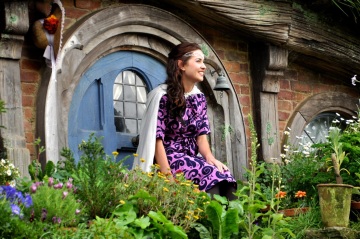 depart, so I hightail it back to sneak in my own picture of the actress, who I guess will be in the Smaug film? We’ll see. Actually, before getting to Bag End our guide pointed to a couple Hobbit Houses off to the side that he will not take us to, since they were just recently built for the Smaug sequel and Peter Jackson doesn’t want people to see them until after the film (why?). I take pictures with the telephoto lens. They should be in the Smaug movie; I’ll look for them (and say I was there! Sort of).
depart, so I hightail it back to sneak in my own picture of the actress, who I guess will be in the Smaug film? We’ll see. Actually, before getting to Bag End our guide pointed to a couple Hobbit Houses off to the side that he will not take us to, since they were just recently built for the Smaug sequel and Peter Jackson doesn’t want people to see them until after the film (why?). I take pictures with the telephoto lens. They should be in the Smaug movie; I’ll look for them (and say I was there! Sort of).
THE GREEN DRAGON
 The Green Dragon – and the mill and bridge – were rebuilt, exactly replicating the first temporary structures. This is a functional restaurant and bar, catering only to the tourists. They serve specially brewed (just for them!) ales and ciders, as well as “Hobbit fayre” like beef-and-ale pie or cold-pork pie. And a boatload of atmosphere! Below are overviews, and as you can see, this is one big inn!
The Green Dragon – and the mill and bridge – were rebuilt, exactly replicating the first temporary structures. This is a functional restaurant and bar, catering only to the tourists. They serve specially brewed (just for them!) ales and ciders, as well as “Hobbit fayre” like beef-and-ale pie or cold-pork pie. And a boatload of atmosphere! Below are overviews, and as you can see, this is one big inn!
So – to the Dragon! And let us not forget the cute mill.
Below is the Green Dragon exterior – too big to get it in one image! It is impressive.
Again, up close there is a lot of detail to see, such as the carving on these two different bays:
 As charming as the outside is, thatch roof and all, the inside is even better. It successfully makes you feel like a Hobbit yourself, with its circular windows and doors. Isn’t that a Ginger Hobbit there, partaking? Everywhere inside are huge (huge and real!) beams and cross timbers, all smooth and polished. The subdued lighting gives the impression there are candles behind the glass. The pictures below don’t quite capture the ambiance, but you’ll get the idea:
As charming as the outside is, thatch roof and all, the inside is even better. It successfully makes you feel like a Hobbit yourself, with its circular windows and doors. Isn’t that a Ginger Hobbit there, partaking? Everywhere inside are huge (huge and real!) beams and cross timbers, all smooth and polished. The subdued lighting gives the impression there are candles behind the glass. The pictures below don’t quite capture the ambiance, but you’ll get the idea:
Although the place is huge and has some larger rooms, it is also nicely broken up into smaller, cozy corners, as shown:
 The attention to detail is also present inside, evident in things like hanging jackets and (Hobbit) portraits on the walls.
The attention to detail is also present inside, evident in things like hanging jackets and (Hobbit) portraits on the walls. 
And let’s not forget the Inn’s namesake Green Dragon: It’s truly gorgeous.
Finally (were you despairing?), the inn’s food and drink. Serving the trapped tourists at the end of the tour (you get a free drink), what would you expect for prices and quality?
We had low expectations, but the prices looked good, so why not? Besides, it was an excuse for savoring the interior (and the fireplace). We ordered beef and ale pies. I had an ale, Ginger the cider. The pies were small, to be sure, but extremely good, as were the drinks. Surprise!! We would happily have had more, but the day was over and the bus was leaving. It was indeed a delight to almost believe in the existence of Hobbits for awhile, and to visit the Shire.
 expensive) trips that allow photos are quite a bit longer, 3+ hours. And really, in all cases the major attraction of these tours is the glowworms, which we’ll get. We start by walking into a cave, then hopping in a boat for a short drift through the glowworm region. Cave exit is shown in the picture (which I’m allowed to take).
expensive) trips that allow photos are quite a bit longer, 3+ hours. And really, in all cases the major attraction of these tours is the glowworms, which we’ll get. We start by walking into a cave, then hopping in a boat for a short drift through the glowworm region. Cave exit is shown in the picture (which I’m allowed to take). smiles. The female multi-tasks and finds time to lay eggs during the orgies, the eggs hatch, and the small 3mm larvae attach themselves to the cave roof. They then lower 20-30 basically invisible mucus-and-silk threads (like fishing lines – more later). The picture to the left shows them, illuminated from the side. How did I take this photo? Alas, I took it directly from the brochure, but it might as well be my “live” picture. It looks like this, folks! Without side lighting, however, they are invisible. Caves, you may know, are dark. Normally. But
smiles. The female multi-tasks and finds time to lay eggs during the orgies, the eggs hatch, and the small 3mm larvae attach themselves to the cave roof. They then lower 20-30 basically invisible mucus-and-silk threads (like fishing lines – more later). The picture to the left shows them, illuminated from the side. How did I take this photo? Alas, I took it directly from the brochure, but it might as well be my “live” picture. It looks like this, folks! Without side lighting, however, they are invisible. Caves, you may know, are dark. Normally. But  glowworms are bioluminescent, producing a mostly blue, greenish-tinged glow. When your eyes adjust to the dark, there they are, everywhere, shining like blue stars. Pretty cool. The brochure picture to the left gives you the idea of what you would see, but it is much better in the flesh in the cave with the shining stars just a few feet over your head. So what is the story here? The bioluminescence attracts flying insects in the dark cave. They encounter the hanging mucus threads and get stuck. The larvae pulls up the line, eats the ensnared prey, and drops down another line. The larvae grow from a few mm to the size and shape of a matchstick, so this process works pretty well. It’s scary out there, folks! It’s The Blob of the insect world (old SF movie to you newbies). But for us, these Blue Meanies are just really, really fairy-like magical. Sorry I don’t have better pictures to show you, but it probably would have been hard to capture them without a tripod.
glowworms are bioluminescent, producing a mostly blue, greenish-tinged glow. When your eyes adjust to the dark, there they are, everywhere, shining like blue stars. Pretty cool. The brochure picture to the left gives you the idea of what you would see, but it is much better in the flesh in the cave with the shining stars just a few feet over your head. So what is the story here? The bioluminescence attracts flying insects in the dark cave. They encounter the hanging mucus threads and get stuck. The larvae pulls up the line, eats the ensnared prey, and drops down another line. The larvae grow from a few mm to the size and shape of a matchstick, so this process works pretty well. It’s scary out there, folks! It’s The Blob of the insect world (old SF movie to you newbies). But for us, these Blue Meanies are just really, really fairy-like magical. Sorry I don’t have better pictures to show you, but it probably would have been hard to capture them without a tripod.



























